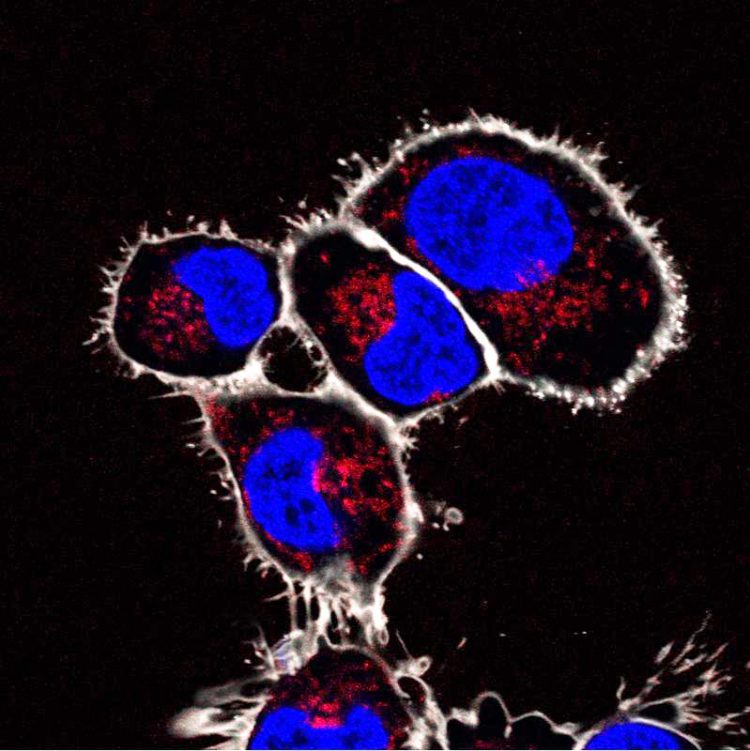Tiny implants for cells are functional in vivo

Artificial organelles in the scavenger cells of a zebrafish that were made visible by a fluorescent reaction. University of Basel, Department of Pharmaceutical Sciences
In the cells of higher organisms, organelles such as the nucleus or mitochondria perform a range of complex functions necessary for life. In the networks of the Swiss Nanoscience Institute and the NCCR “Molecular Systems Engineering”, the group led by Professor Cornelia Palivan from the Department of Chemistry at the University of Basel is working to produce organelles of this kind in the laboratory, to introduce them into cells, and to control their activity in response to the presence of external factors (e.g. change in pH values or reductive conditions).
These cellular implants could, for example, carry enzymes able to convert a pharmaceutical ingredient into the active substance and release it “on demand” under specific conditions. Administering drugs in this way could considerably reduce both the amounts used and the side effects. It would allow treatment to be delivered only when required by changes associated with pathological conditions (e.g., a tumor).
Tiny capsules with an enzymatic cargo
The artificial organelles are based on tiny capsules that form spontaneously in solution from polymers and can enclose various macromolecules such as enzymes. The artificial organelles presented here contained a peroxidase enzyme that only begins to act when specific molecules penetrate the wall of the capsules and support the enzymatic reaction.
To control the passage of substances, the researchers incorporated chemically modified natural membrane proteins into the wall of the capsules. These act as gates that open according to the glutathione concentration in the cell.
At a low glutathione value, the pore of the membrane proteins are “closed” – that is, no substances can pass. If the glutathione concentration rises above a certain threshold, the protein gate opens and substances from outside can pass through the pore into the cavity of the capsule. There, they are converted by the enzyme inside and the product of the reaction can leave the capsule through the open gate.
Also effective in living organisms
In collaboration with the group led by Professor Jörg Huwyler of the Department of Pharmaceutical Sciences at the University of Basel, the artificial organelles have also been studied in vivo. “We’ve now been able to integrate these controllable artificial organelles into the cells of a living organism for the first time,” says Cornelia Palivan.
The researchers chose zebrafish embryos because their transparent bodies allow excellent tracking of the cellular implants under a microscope when they are marked with a fluorescent dye.
After the artificial organelles were injected, they were “eaten” by macrophages and therefore made their way into the organism. The researchers were then able to show that the peroxidase enzyme trapped inside the artificial organelle was activated when hydrogen peroxide produced by the macrophages entered through the protein gates.
“In this study, we showed that the artificial organelles, which are inspired by nature, continue to work as intended in the living organism, and that the protein gate we incorporated not only works in cell cultures but also in vivo,” comments Tomaž Einfalt, the first author of the article and graduate of the PhD School of the Swiss Nanoscience Institute. The idea of using artificial organelles as cell implants with the potential to produce active pharmaceutical compounds, for example, opens up new perspectives for patient-oriented protein therapy.
Original source
T. Einfalt, D. Witzigmann, C. Edlinger, S. Sieber, R. Goers, A. Najer, M. Spulber, O. Fischer, J. Huwyler, and C. G. Palivan
Biomimetic artificial organelles with in vitro and in vivo activity triggered by reduction in microenvironment
Nature Communications (2018), doi: 10.1038/s41467-018-03560-x
Further information
Prof. Dr. Cornelia G. Palivan, University of Basel, Department of Chemistry, tel. +41 61 207 38 39, email: cornelia.palivan@unibas.ch
Prof. Dr. Jörg Huwyler, University of Basel, Department of Pharmaceutical Sciences, tel. +41 61 207 15 13, email: joerg.huwyler@unibas.ch
Media Contact
More Information:
http://www.unibas.chAll latest news from the category: Interdisciplinary Research
News and developments from the field of interdisciplinary research.
Among other topics, you can find stimulating reports and articles related to microsystems, emotions research, futures research and stratospheric research.
Newest articles

Recharging the Future: Batteries Built for Extreme Cold Using Negative Thermal Expansion
Most solids expand as temperatures increase and shrink as they cool. Some materials do the opposite, expanding in the cold. Lithium titanium phosphate is one such substance and could provide…

Self-Destructing Cancer Cells: Cutting-Edge RNA Breakthrough
Jülich scientists use novel RNA technology to selectively switch off tumours in the brain. An Adaptable Platform Technology That Destroys Glioblastoma Cancer Cells Using a special RNA molecule, a team…

Endurance Training: Transforming Lives of Heart Failure Patients
Can strength and endurance training be beneficial for patients with a certain form of heart failure? A research team from Greifswald investigated this question together with seven other research centers…



